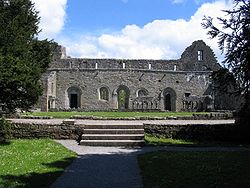- Cong Abbey
-
Cong Abbey
Cúnga Fheichín
Monastery information Order Augustinian Established 7th century Diocese Archdiocese of Tuam People Founder(s) Saint Feichin Site Location County Mayo Cong Abbey is a historic site located at Cong, on the borders of counties Galway and Mayo, in Ireland's province of Connacht. Founded in the early 7th century, by Saint Feichin, the abbey was destroyed by fire in the early 12th century. Turlough Mor O’Connor, the High King of Ireland, refounded the abbey circa 1135. His son Rory O'Connor, the last High King of Ireland before the Norman invasion, constructed new buildings and also lived the last 15 years of his life at the abbey[1], dying in 1198. The monastery adopted the Augustinian rule some years later.
The Norman knight, William de Burgh, attacked Cong in 1203, and again the abbey was rebuilt.
The present church, and possibly the fragmentary cloister where the monks worked and prayed, belong to the rebuilding of the early 13th century. The north doorway of the church, and the elaborate doorways that open onto the cloister from the east range of the monastery, may pre-date the attack by William de Burgo. The doorway with two fine windows on either side belongs to the chapter house, where the monastery’s daily business was conducted as well as a chapter of the rule being read each day. This was also where the community gathered to confess their sins publicly. The sculpture in the abbey, which is some of the finest in Ireland, suggests links to French styles of the period.
The grounds of the abbey also contain a monk’s fishing house, probably built in the 15th or 16th century, on the bank of the River Cong leading towards nearby Lough Corrib. The house is built on a platform of stones over a small arch which allows the river to flow underneath the floor. There is a trapdoor in the floor which may have been used for a net, and the monks could sit beside the fireplace making the task of catching fish a little more comfortable. It is thought that a line was connected from the fishing house to the monastery kitchen to alert the cook to fresh fish.
The Annals of the Four Masters record that in 1150, Muireadhach Ua Dubhthaigh, Archbishop of Connacht, died at Cong aged 75[2]. His name is inscribed upon the processional Cross of Cong[3]
The first restoration of the abbey was started by Benjamin Guinness soon after he had bought nearby Ashford Castle in 1855. Cong abbey is a national monument in the care of the Commissioners for Public Works.
See also
References
- ^ Sir W. Wilde Lough Corrib, p. 181.
- ^ http://celt.ucc.ie/publishd.html
- ^ Stokes, Margaret. Early Christian Art in Ireland. Part 1. London: Chapman and Hall Limited, 1887–1894
Coordinates: 53°32′22.20″N 9°17′14.29″W / 53.5395°N 9.2873028°W
Categories:- History of Ireland
- Medieval architecture
- Augustinian monasteries in the Republic of Ireland
- Ruins in the Republic of Ireland
- Religion in County Mayo
- Visitor attractions in County Mayo
- National Monuments in County Mayo
Wikimedia Foundation. 2010.








